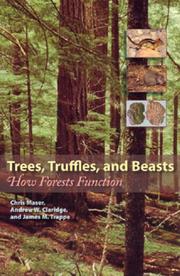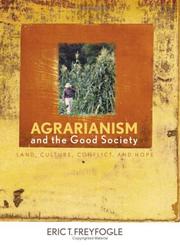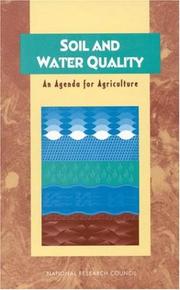| Listing 1 - 5 of 5 |
Sort by
|

ISBN: 1281397210 9786611397210 0813544653 9780813544656 9780813542256 0813542251 9780813542263 081354226X 9781281397218 6611397213 Year: 2008 Publisher: New Brunswick, NJ
Abstract | Keywords | Export | Availability | Bookmark
 Loading...
Loading...Choose an application
- Reference Manager
- EndNote
- RefWorks (Direct export to RefWorks)
In today's world of specialization, people are attempting to protect the Earth's fragile state by swapping limousines for hybrids and pesticide-laced foods for organic produce. At other times, environmental awareness is translated into public relations gimmicks or trendy commodities. Moreover, simplistic policies, like single-species protection or planting ten trees for every tree cut down, are touted as bureaucratic or industrial panaceas. Because today's decisions are tomorrow's consequences, every small effort makes a difference, but a broader understanding of our environmental problems is necessary to the development of sustainable ecosystem policies. In Trees, Truffles, and Beasts, Chris Maser, Andrew W. Claridge, and James M. Trappe make a compelling case that we must first understand the complexity and interdependency of species and habitats from the microscopic level to the gigantic. Comparing forests in the Pacific Northwestern United States and Southeastern mainland of Australia, the authors show how easily observable speciesùtrees and mammalsùare part of a complicated infrastructure that includes fungi, lichens, and organisms invisible to the naked eye, such as microbes. Eminently readable, this important book shows that forests are far more complicated than most of us might think, which means simplistic policies will not save them. Understanding the biophysical intricacies of our life-support systems just might.

ISBN: 0813124395 9786613233134 0813134889 1283233134 0813172500 081313823X 9780813172507 9780813138237 9780813124391 Year: 2007 Publisher: Lexington University Press of Kentucky
Abstract | Keywords | Export | Availability | Bookmark
 Loading...
Loading...Choose an application
- Reference Manager
- EndNote
- RefWorks (Direct export to RefWorks)
Every society expresses its fundamental values and hopes in the ways it shapes and inhabits its landscapes. In this literate and wide-ranging exploration, Eric T. Freyfogle raises difficult questions about American culture while illuminating the intellectual origins of urban sprawl, dwindling wildlife habitats, over-engineered rivers, and degraded forests and grasslands. These land-use crises, he contends, arise mostly because of cultural attitudes that once made sense on the American frontier but now threaten our natural resources. To support and sustain healthy communities, profound adjus
Environmental degradation - United States. --- Environmental degradation -- United States. --- Environmental ethics - United States. --- Environmental ethics -- United States. Human ecology -- United States. --- Human ecology - United States. --- Land use - Environmental aspects - United States. --- Land use -- Environmental aspects -- United States. --- National characteristics, American. --- Social values - United States. --- Social values -- United States. --- Land use --- Environmental degradation --- Environmental ethics --- Human ecology --- Social values --- National characteristics, American --- Real Estate, Housing & Land Use --- Business & Economics --- Environmental aspects --- American national characteristics

ISBN: 0309049334 9786610196111 1280196114 0309585716 0585037809 9780585037806 9780309049337 Year: 1993 Publisher: Washington, D.C. National Academy Press
Abstract | Keywords | Export | Availability | Bookmark
 Loading...
Loading...Choose an application
- Reference Manager
- EndNote
- RefWorks (Direct export to RefWorks)
TECHNOLOGY & ENGINEERING --- Agriculture / General --- Soil management --- Soils --- Water quality management --- Sediment control --- Agricultural ecology --- Agriculture - General --- Agriculture --- Earth & Environmental Sciences --- Quality --- 631.6.02 --- Soil and water conservation. Erosion control --- 631.6.02 Soil and water conservation. Erosion control --- Quality. --- Control of sediment --- Earth (Soils) --- Mold, Vegetable --- Mould, Vegetable --- Soil --- Vegetable mold --- Management --- Agricultural resources --- Plant growing media --- Regolith --- Land capability for agriculture --- Soil science --- Agronomy --- Hydraulic engineering --- United States --- Soil management - United States. --- Soils - United States - Quality. --- Sediment control - United States. --- Agricultural ecology - United States.
Book
ISBN: 9783319198095 3319198084 9783319198088 3319198092 Year: 2015 Publisher: Cham : Springer International Publishing : Imprint: Springer,
Abstract | Keywords | Export | Availability | Bookmark
 Loading...
Loading...Choose an application
- Reference Manager
- EndNote
- RefWorks (Direct export to RefWorks)
Forest landscape disturbances are a global phenomenon. Simulation models are an important tool in understanding these broad scale processes and exploring their effects on forest ecosystems. This book contains a collection of insights from a group of ecologists who address a variety of processes: physical disturbances such as drought, wind, and fire; biological disturbances such as defoliating insects and bark beetles; anthropogenic influences; interactions among disturbances; effects of climate change on disturbances; and the recovery of forest landscapes from disturbances—all from a simulation modeling perspective. These discussions and examples offer a broad synopsis of the state of this rapidly evolving subject.
Life Sciences. --- Landscape Ecology. --- Forestry. --- Applied Ecology. --- Life sciences. --- Landscape ecology. --- Forests and forestry. --- Sciences de la vie --- Ecologie du paysage --- Forêts et sylviculture --- Ecological disturbances -- Canada. --- Ecological disturbances -- United States. --- Forest ecology -- Canada. --- Forest ecology -- United States. --- Forest management -- Canada. --- Forest management -- United States. --- Earth & Environmental Sciences --- Ecology --- Forest management --- Forest ecology --- Ecological disturbances --- Disturbance ecology --- Disturbances, Ecological --- Ecological perturbations --- Ecosystem disturbances --- Ecosystem perturbations --- Environmental disturbances --- Environmental perturbations --- Perturbations, Ecological --- Forests and forestry --- Applied ecology. --- Environmental protection --- Nature conservation --- Forest land --- Forest lands --- Forest planting --- Forest production --- Forest sciences --- Forestation --- Forested lands --- Forestland --- Forestlands --- Forestry --- Forestry industry --- Forestry sciences --- Land, Forest --- Lands, Forest --- Silviculture --- Sylviculture --- Woodlands --- Woods (Forests) --- Agriculture --- Natural resources --- Afforestation --- Arboriculture --- Logging --- Timber --- Tree crops --- Trees
Book
ISBN: 9400716192 9400716206 Year: 2011 Publisher: Dordrecht [Netherlands] : Springer,
Abstract | Keywords | Export | Availability | Bookmark
 Loading...
Loading...Choose an application
- Reference Manager
- EndNote
- RefWorks (Direct export to RefWorks)
There is a rising concern among natural resource scientists and managers about decline of the many plant and animal species associated with early successional habitats, especially within the Central Hardwood Region. Open sites with grass, herbaceous, shrub, or incomplete young forest cover are disappearing as abandoned farmland and pastures return to forest and recently harvested or disturbed forests re-grow. There are many questions about “why, what, where, and how” to manage for early successional habitats. Tradeoffs among ecological services such as carbon storage, hydrologic processes, forest products, and biotic diversity between young, early successional habitats and mature forest are not fully understood. Personal values and attitudes regarding forest management for conservation purposes versus "letting nature take its course," complicate finding common ground on whether and how to create or sustain early successional habitats. In this book, expert scientists and experienced land managers synthesize knowledge and original scientific work to address critical questions sparked by the decline of early successional habitats. We focus on habitats created by natural disturbances or management of upland hardwood forests and discuss how they can be sustainably created and managed in a landscape context. Together, chapters written by ecologists, conservationists, and land managers provide a balanced view of how past, current, and future scenarios affect the extent and quality of early successional habitat and implications for ecosystem services and disturbance-dependant plants and animals in upland hardwood forest of the Central Hardwood Region. .
Forest ecology -- United States. --- Forest ecology. --- Forestry -- United States. --- Forests. --- Forest succession --- Forest ecology --- Forest management --- Earth & Environmental Sciences --- Forestry --- Ecology --- Life sciences. --- Applied ecology. --- Biodiversity. --- Ecosystems. --- Conservation biology. --- Ecology. --- Wildlife. --- Fish. --- Life Sciences. --- Conservation Biology/Ecology. --- Fish & Wildlife Biology & Management. --- Applied Ecology. --- Wildlife management. --- Endangered ecosystems. --- Environmental protection --- Nature conservation --- Threatened ecosystems --- Biotic communities --- Biological diversification --- Biological diversity --- Biotic diversity --- Diversification, Biological --- Diversity, Biological --- Biology --- Biocomplexity --- Ecological heterogeneity --- Numbers of species --- Animal populations --- Game management --- Management, Game --- Management, Wildlife --- Plant populations --- Wildlife resources --- Natural resources --- Wildlife conservation --- Management --- Ecology . --- Biocenoses --- Biocoenoses --- Biogeoecology --- Biological communities --- Biomes --- Biotic community ecology --- Communities, Biotic --- Community ecology, Biotic --- Ecological communities --- Ecosystems --- Natural communities --- Population biology --- Fish --- Pisces --- Aquatic animals --- Vertebrates --- Fisheries --- Fishing --- Ichthyology --- Balance of nature --- Bionomics --- Ecological processes --- Ecological science --- Ecological sciences --- Environment --- Environmental biology --- Oecology --- Environmental sciences
| Listing 1 - 5 of 5 |
Sort by
|

 Search
Search Feedback
Feedback About UniCat
About UniCat  Help
Help News
News